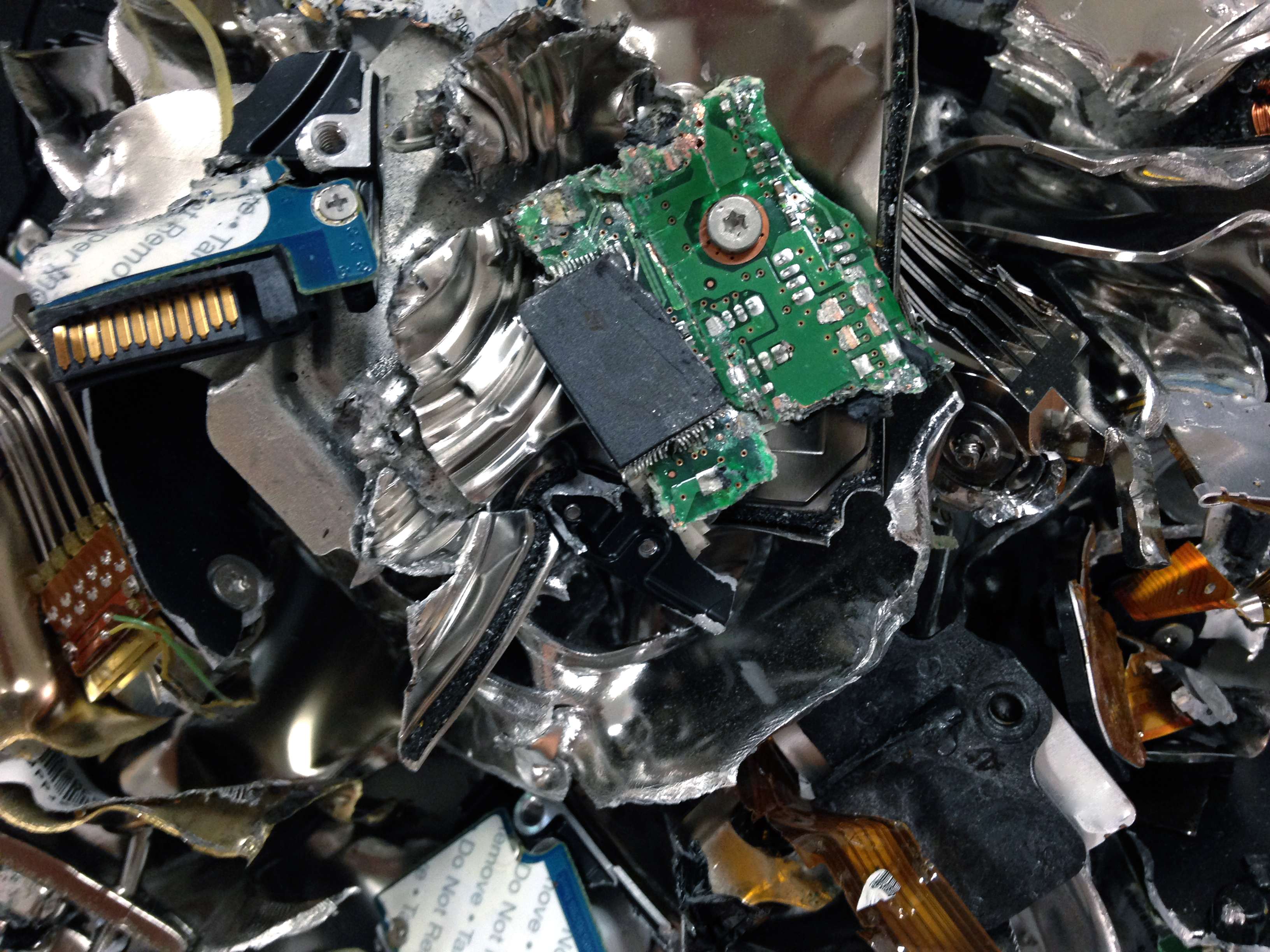|
Gutmann Method
The Gutmann method is an algorithm for securely erasing the contents of computer hard disk drives, such as files. Devised by Peter Gutmann and Colin Plumb and presented in the paper ''Secure Deletion of Data from Magnetic and Solid-State Memory'' in July 1996, it involved writing a series of 35 patterns over the region to be erased. The selection of patterns assumes that the user does not know the encoding mechanism used by the drive, so it includes patterns designed specifically for three types of drives. A user who knows which type of encoding the drive uses can choose only those patterns intended for their drive. A drive with a different encoding mechanism would need different patterns. Most of the patterns in the Gutmann method were designed for older MFM/ RLL encoded disks. Gutmann himself has noted that more modern drives no longer use these older encoding techniques, making parts of the method irrelevant. He said "In the time since this paper was published, some people h ... [...More Info...] [...Related Items...] OR: [Wikipedia] [Google] [Baidu] |
Algorithm
In mathematics and computer science, an algorithm () is a finite sequence of Rigour#Mathematics, mathematically rigorous instructions, typically used to solve a class of specific Computational problem, problems or to perform a computation. Algorithms are used as specifications for performing calculations and data processing. More advanced algorithms can use Conditional (computer programming), conditionals to divert the code execution through various routes (referred to as automated decision-making) and deduce valid inferences (referred to as automated reasoning). In contrast, a Heuristic (computer science), heuristic is an approach to solving problems without well-defined correct or optimal results.David A. Grossman, Ophir Frieder, ''Information Retrieval: Algorithms and Heuristics'', 2nd edition, 2004, For example, although social media recommender systems are commonly called "algorithms", they actually rely on heuristics as there is no truly "correct" recommendation. As an e ... [...More Info...] [...Related Items...] OR: [Wikipedia] [Google] [Baidu] |
Hard Disk
A hard disk drive (HDD), hard disk, hard drive, or fixed disk is an electro-mechanical data storage device that stores and retrieves digital data using magnetic storage with one or more rigid rapidly rotating hard disk drive platter, platters coated with magnetic material. The platters are paired with disk read-and-write head, magnetic heads, usually arranged on a moving actuator arm, which read and write data to the platter surfaces. Data is accessed in a random-access manner, meaning that individual Block (data storage), blocks of data can be stored and retrieved in any order. HDDs are a type of non-volatile storage, retaining stored data when powered off. Modern HDDs are typically in the form of a small disk enclosure, rectangular box. Hard disk drives were introduced by IBM in 1956, and were the dominant secondary storage device for History of general-purpose CPUs, general-purpose computers beginning in the early 1960s. HDDs maintained this position into the modern er ... [...More Info...] [...Related Items...] OR: [Wikipedia] [Google] [Baidu] |
Computer Forensics
Computer forensics (also known as computer forensic science) is a branch of digital forensics, digital forensic science pertaining to evidence found in computers and digital storage media. The goal of computer forensics is to examine digital media in a forensically sound manner with the aim of identifying, preserving, recovering, analyzing, and presenting facts and opinions about the digital information. Although it is most often associated with the investigation of a wide variety of computer crime, computer forensics may also be used in civil proceedings. The discipline involves similar techniques and principles to data recovery, but with additional guidelines and practices designed to create a legal audit trail. Evidence from computer forensics investigations is usually subjected to the same guidelines and practices as other digital evidence. It has been used in a number of high-profile cases and is accepted as reliable within U.S. and European court systems. Overview In the ... [...More Info...] [...Related Items...] OR: [Wikipedia] [Google] [Baidu] |
Data Recovery
In computing, data recovery is a process of retrieving deleted, inaccessible, lost, corrupted, damaged, overwritten or formatted data from computer data storage#Secondary storage, secondary storage, removable media or Computer file, files, when the data stored in them cannot be accessed in a usual way. The data is most often salvaged from storage media such as internal or external hard disk drives (HDDs), solid-state drives (SSDs), USB flash drives, Magnetic-tape data storage, magnetic tapes, Compact disc, CDs, DVDs, RAID subsystems, and other electronics, electronic devices. Recovery may be required due to physical damage to the storage devices or logical damage to the file system that prevents it from being Mount (computing), mounted by the host operating system (OS). Logical failures occur when the hard drive devices are functional but the user or automated-OS cannot retrieve or access data stored on them. Logical failures can occur due to corruption of the engineering chip, l ... [...More Info...] [...Related Items...] OR: [Wikipedia] [Google] [Baidu] |
Data Remanence
Data remanence is the residual representation of digital data that remains even after attempts have been made to remove or erase the data. This residue may result from data being left intact by a nominal file deletion operation, by reformatting of storage media that does not remove data previously written to the media, or through physical properties of the storage media that allow previously written data to be recovered. Data remanence may make inadvertent disclosure of sensitive information possible should the storage media be released into an uncontrolled environment (''e.g.'', thrown in the bin (trash) or lost). Various techniques have been developed to counter data remanence. These techniques are classified as clearing, purging/sanitizing, or destruction. Specific methods include overwriting, degaussing, encryption, and media destruction. Effective application of countermeasures can be complicated by several factors, including media that are inaccessible, media that c ... [...More Info...] [...Related Items...] OR: [Wikipedia] [Google] [Baidu] |
Partial-response Maximum-likelihood
In computer data storage, partial-response maximum-likelihood (PRML) is a method for recovering the digital data from the weak analog read-back signal picked up by the head of a magnetic disk drive or tape drive. PRML was introduced to recover data more reliably or at a greater areal-density than earlier simpler schemes such as peak-detection. These advances are important because most of the digital data in the world is stored using magnetic storage on hard disk or tape drives. Ampex introduced PRML in a tape drive in 1984. IBM introduced PRML in a disk drive in 1990 and also coined the acronym PRML. Many advances have taken place since the initial introduction. Recent read/write channels operate at much higher data-rates, are fully adaptive, and, in particular, include the ability to handle nonlinear signal distortion and non-stationary, colored, data-dependent noise ( PDNP or NPML). ''Partial response'' refers to the fact that part of the response to an individual bit may occ ... [...More Info...] [...Related Items...] OR: [Wikipedia] [Google] [Baidu] |
Cryptographically Secure Pseudorandom Number Generator
A cryptographically secure pseudorandom number generator (CSPRNG) or cryptographic pseudorandom number generator (CPRNG) is a pseudorandom number generator (PRNG) with properties that make it suitable for use in cryptography. It is also referred to as a cryptographic random number generator (CRNG). Background Most cryptographic applications require random numbers, for example: * key generation * initialization vectors * nonces * salts in certain signature schemes, including ECDSA and RSASSA-PSS * token generation The "quality" of the randomness required for these applications varies. For example, creating a nonce in some protocols needs only uniqueness. On the other hand, the generation of a master key requires a higher quality, such as more entropy. And in the case of one-time pads, the information-theoretic guarantee of perfect secrecy only holds if the key material comes from a true random source with high entropy, and thus just any kind of pseudorandom number gener ... [...More Info...] [...Related Items...] OR: [Wikipedia] [Google] [Baidu] |
National Bureau Of Economic Research
The National Bureau of Economic Research (NBER) is an American private nonprofit research organization "committed to undertaking and disseminating unbiased economic research among public policymakers, business professionals, and the academic community." The NBER is known for proposing start and end dates for recessions in the United States. Many chairpersons of the Council of Economic Advisers were previously NBER research associates, including the former NBER president and Harvard professor Martin Feldstein. The NBER's current president and CEO is James M. Poterba of MIT. History Founding The NBER was established in 1920 following debates during the Progressive era over income distribution. Founded by Malcolm Rorty and Nachum Stone, the NBER aimed to fill the information gap on economic data. The organization's research is restricted to presenting data and findings without making policy recommendations. Early years The NBER initially received support from the Carnegie F ... [...More Info...] [...Related Items...] OR: [Wikipedia] [Google] [Baidu] |
Run-length Limited
Run-length limited (RLL) is a line coding technique that is used to send arbitrary data over a communications channel with bandwidth limits. RLL codes are defined by four main parameters: ''m'', ''n'', ''d'', ''k''. The first two, ''m''/''n'', refer to the rate of the code, while the remaining two specify the minimal ''d'' and maximal ''k'' number of zeroes between consecutive ones. This is used in both telecommunication and storage systems that move a medium past a fixed recording head. Specifically, RLL bounds the length of stretches (runs) of repeated bits during which the signal does not change. If the runs are too long, clock recovery is difficult; if they are too short, the high frequencies might be attenuated by the communications channel. By modulating the data, RLL reduces the timing uncertainty in decoding the stored data, which would lead to the possible erroneous insertion or removal of bits when reading the data back. This mechanism ensures that the boundaries b ... [...More Info...] [...Related Items...] OR: [Wikipedia] [Google] [Baidu] |
Hexadecimal
Hexadecimal (also known as base-16 or simply hex) is a Numeral system#Positional systems in detail, positional numeral system that represents numbers using a radix (base) of sixteen. Unlike the decimal system representing numbers using ten symbols, hexadecimal uses sixteen distinct symbols, most often the symbols "0"–"9" to represent values 0 to 9 and "A"–"F" to represent values from ten to fifteen. Software developers and system designers widely use hexadecimal numbers because they provide a convenient representation of binary code, binary-coded values. Each hexadecimal digit represents four bits (binary digits), also known as a nibble (or nybble). For example, an 8-bit byte is two hexadecimal digits and its value can be written as to in hexadecimal. In mathematics, a subscript is typically used to specify the base. For example, the decimal value would be expressed in hexadecimal as . In programming, several notations denote hexadecimal numbers, usually involving a prefi ... [...More Info...] [...Related Items...] OR: [Wikipedia] [Google] [Baidu] |
Binary Numeral System
A binary number is a number expressed in the base-2 numeral system or binary numeral system, a method for representing numbers that uses only two symbols for the natural numbers: typically "0" ( zero) and "1" ( one). A ''binary number'' may also refer to a rational number that has a finite representation in the binary numeral system, that is, the quotient of an integer by a power of two. The base-2 numeral system is a positional notation with a radix of 2. Each digit is referred to as a bit, or binary digit. Because of its straightforward implementation in digital electronic circuitry using logic gates, the binary system is used by almost all modern computers and computer-based devices, as a preferred system of use, over various other human techniques of communication, because of the simplicity of the language and the noise immunity in physical implementation. History The modern binary number system was studied in Europe in the 16th and 17th centuries by Thomas Harrio ... [...More Info...] [...Related Items...] OR: [Wikipedia] [Google] [Baidu] |




